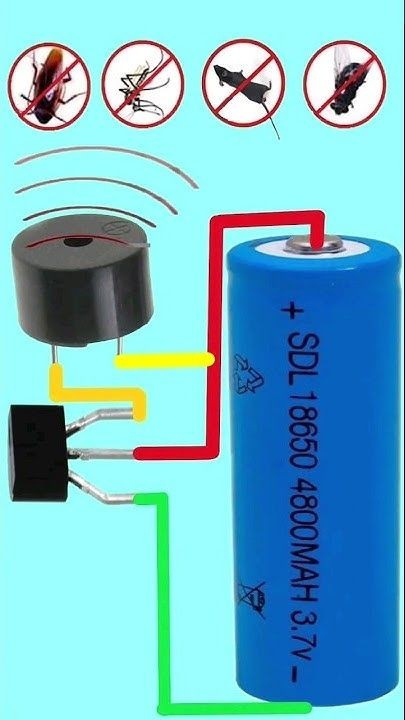This image depicts a simple electronic circuit designed to repel mosquitoes and pests using ultrasonic sound.
Here's a breakdown of the components and their function:
1. Ultrasonic Transducer: The black cylindrical component at the top left is an ultrasonic transducer. It converts electrical signals into ultrasonic sound waves, which are above the frequency range that humans can hear but can be effective in repelling certain insects and small animals.
2. Battery: The large blue component is a rechargeable battery with a capacity of 4800mAh and a voltage of 3.7V. This battery provides the necessary power for the circuit.
3. Transistor: The black component with three leads is a transistor, likely a BJT (Bipolar Junction Transistor). It acts as a switch or amplifier in this circuit, controlling the flow of current to the ultrasonic transducer.
4. Wiring:
• Red Wire: Connects the positive terminal of the battery to the collector of the transistor and one terminal of the ultrasonic transducer.
• Green Wire: Connects the negative terminal of the battery to the emitter of the transistor and the other terminal of the ultrasonic transducer.
• Yellow Wire: Connects the base of the transistor to the circuit, likely to control the transistor's switching action.
How It Works:
- The battery provides a constant voltage to the circuit.
- The transistor is configured to oscillate or switch rapidly, creating pulses of current that drive the ultrasonic transducer.
- The ultrasonic transducer converts these electrical pulses into ultrasonic sound waves, which are emitted into the environment.
Purpose:
• Pest Repellent: The ultrasonic sound waves are intended to be at frequencies that are uncomfortable or disorienting to pests like mosquitoes, rodents, and other insects, encouraging them to leave the area.
Considerations:
• Effectiveness: While ultrasonic devices are marketed as pest repellents, their effectiveness can vary depending on the specific pests and environmental conditions.
• Safety: These devices are generally considered safe for humans and pets, as the ultrasonic frequencies are typically beyond human hearing range.
This circuit is a basic example of how ultrasonic technology can be used for pest control, and it's a common DIY project for those looking to create their own pest repellent devices.






No comments:
Post a Comment